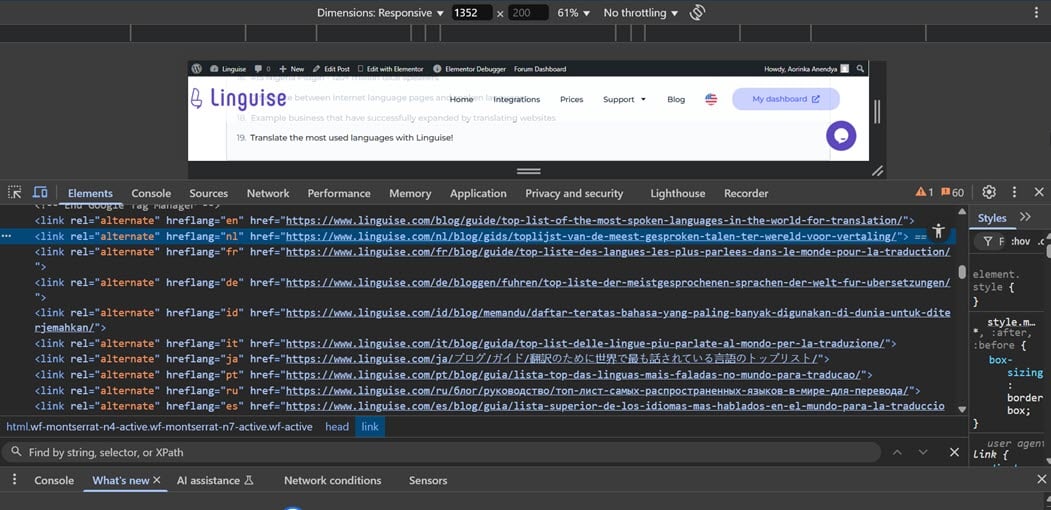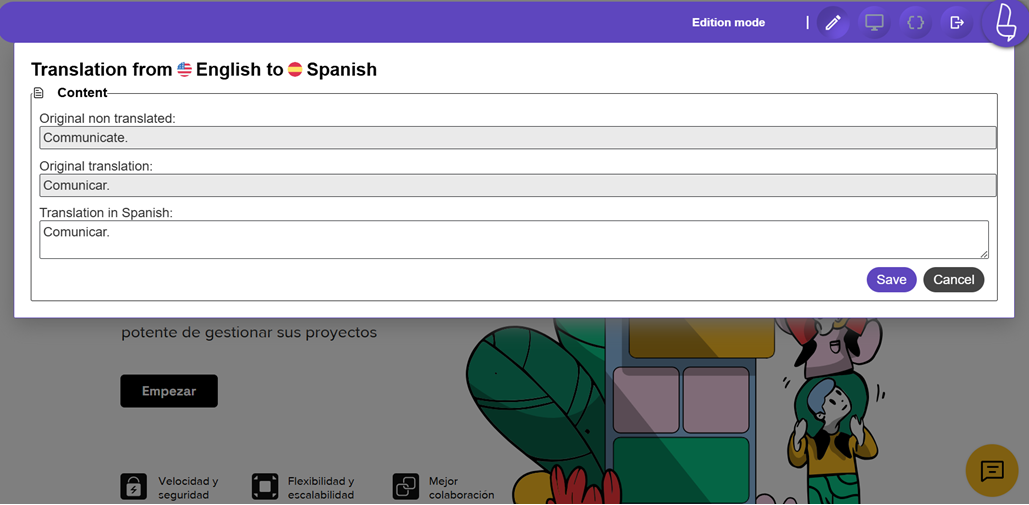Creating a multilingual website on HubSpot is a great step towards reaching an international audience, but the effort can be sub-optimal without the right international SEO strategy.
In this article, we will discuss practical tips that you can implement to optimize your HubSpot multilingual site to make it easier to find in various global markets. From hreflang tags to URL structure strategies, we’ll cover everything in an easy-to-understand and immediately applicable approach. Let’s get started!
The importance of international SEO for your multilingual HubSpot websites

If you’ve already created a multilingual website on HubSpot, optimizing it with an international SEO strategy is the next crucial step. Without the right SEO approach for a global audience, your translation and content creation efforts might not deliver maximum impact. Here are several strong reasons why international SEO is essential for your multilingual site:
- Reaching the first page of Google in your target country – International SEO helps your website appear in local search results based on your target language and location. This makes it easier for audiences in other countries to find your content through search engines like Google, Baidu, or Yandex, each with its algorithm and preferences.
- Keeping foreign visitors engaged longer – Visitors tend to stay longer and interact more when they find content that matches their language and culture. International SEO ensures users are directed to the correct version of your site, offering a more personalized and relevant experience.
- Building trust through localized content – When audiences find content in their language, presented with local standards (such as currency, date formats, or relevant images), it builds trust in your brand. They feel understood, rather than simply “sold to.”
- Opening doors to the global market – With the right international SEO strategy, you open up opportunities to expand your market reach, boost international traffic, and ultimately drive conversions from various regions worldwide. This gives you a competitive edge over brands that rely solely on local SEO or single-language content.
10+ tips to optimize your multilingual HubSpot website for SEO

Creating a multi-language website is not enough. You also need to optimize it for international SEO. Therefore, here are some of the best tips that you can do.
#1 Understand your global audience

The first step in an international SEO strategy is understanding your audience in each country. Knowing your global audience is crucial for creating relevant content and avoiding communication missteps that could harm your brand.
For example, a common term in one country might be offensive in another. By understanding search habits, local culture, and social context, you can build stronger connections with international visitors while boosting the overall effectiveness of your SEO strategy. Here are a few key actions to take.
- Conduct market research per country: Find out what users in a specific country are searching for, how they phrase their queries, and who the local competitors are.
- Use tools like Google Trends or SEMrush: These tools can help you analyze search trends by location and language.
- Segment your international user personas: Create distinct personas for each market to ensure your content strategy is highly targeted.
Additionally, understanding your global audience enables you to craft more relevant content strategies and SEO optimizations, increasing your chances of reaching and engaging users across different countries.
#2 Use a URL structure strategy wisely
URL structure plays an important role in international SEO because it affects how search engines understand your site’s language and location versions. Clean and consistent URLs make it easier for search engines to index pages correctly while signaling the geographic location and target language. There are several URL structure options you can choose from.
- ccTLD (country-code Top Level Domain): For example, example.fr for France or example.de for Germany. This sends a strong signal of location but requires a separate domain for each country. It’s ideal for large businesses with a strong local presence in each country and local marketing teams running separate SEO and content strategies.
- Subdomain: For example, fr.example.com, de.example.com. More flexible, though its geolocation signal isn’t as strong as ccTLD. This is a good choice if you want to separate content by region or technical team without purchasing new domains. It also works well if your development team or CMS can manage different languages independently, and you want flexibility without having to build domain authority from scratch, like with ccTLDs.
- Subfolder: For example, example.com/fr/, example.com/de/. This is the most common approach and makes centralized SEO management easier. It suits small to large teams looking to go global without significant technical overhead.
Choose the structure that best aligns with your resources and ensure consistency in its implementation. Avoid mixing different URL structures, as this can confuse search engines.
#3 Implement hreflang tags
The hreflang tag is an HTML element that tells search engines which language or regional version of a page to display. In other words, this tag helps Google show the most relevant page based on the user’s location and language. To implement hreflang tag, there are several things to do.
- Install the hreflang tag on every multilingual page: For example, if you have pages in English and French, include hreflang tags referencing both versions. Many translation tools automatically add these tags.
- Use the correct format: Example: <link rel=”alternate” hreflang=”fr” href=”https://example.com/fr/” />
- Ensure consistency: Every page should reference each other using hreflang so that search engines consider it valid.
Without hreflang tags, you might encounter a problem known as “incorrect regional URL indexing,” where users from Japan, for example, are directed to the English or Spanish page instead. This reduces the quality of the user experience and can lower dwell time and increase the bounce rate. Hreflang helps prevent this, ensuring Google doesn’t treat different language versions as duplicates. The following is an example of implementing hreflang on a website.

#4 Avoid duplicate content across language versions

One of the challenges in creating a multilingual website is the risk of duplicate content. Search engines may consider it duplicate content if you simply copy the same page to multiple different URLs without changing the language or context. Here are some tips to avoid duplicate content issues.
- Avoid using automatic translations without human editing.
- Use hreflang tags to indicate that the pages are different language versions.
- Create content relevant to the local audience, not just a literal translation.
Additionally, canonical tags are crucial in addressing duplicate content issues on multilingual websites, especially when different language versions have very similar or identical content. The canonical tag tells search engines which page is the content’s main (original) version, preventing duplicate content penalties and helping consolidate SEO signals to the correct URL.
For example, if you have two pages.
- English version: https://example.com/en/product
- Indonesian version: https://mysite.com/id/produk
If both are very similar and you want to prioritize the English version, you can add the following to the Indonesian page:
<link rel="canonical" href="https://example.com/en/product" />
#5 Translate and localize your content
Translating content is not just about replacing words from one language to another. You must also localize the content to align with the target market’s culture, norms, and preferences. Here are some steps you should take.
- Use professional translators who understand the local context, not just automatic tools. Or, use translation tools that provide an editor feature for the translations that can be used for localization.
- Adapt elements such as images, currency, date formats, and tone of language.
- Consider local references in the content, such as product examples, customs, or trends in that region.
- Localize dialects of the language, as each country can have various dialects. For example, Spanish in Spain is different from Spanish in Latin America. Using words or expressions unfamiliar to the local audience can make the content feel less authentic.
Content that feels “close” to the reader in the target country will be easier to trust, share, and support conversions, which positively impacts your SEO and business. It would be even better if the translation tool you use provides a live editor feature that can be used for content localization such as Linguise’s.

#6 Optimize metadata and ALT text in each language
Optimizing metadata (like titles and descriptions) and ALT text for each language version of your website is crucial for multilingual SEO. These elements help search engines understand the content of your pages and improve their visibility in search results. Here’s what you need to do.
- Use language-specific metadata: Ensure that the title tags, meta descriptions, and meta keywords are translated and localized for each language version of your site. This includes not just direct translations but also optimizing them for local search terms most relevant to the target audience.
- Optimize ALT text for images: Images should have ALT text that describes the image’s content in the language of the page on which it’s on. For example, if you have an image of a product, the ALT text should describe the product and use the local name or terminology in the target language.
- Target local keywords: It is important to use local keywords in your metadata, in addition to language translation. Words or phrases that work in one country may not be as effective in another, so research international keyword trends for each language.
By tailoring metadata and ALT text to each specific language version, you ensure your site is more easily understood by users and search engines in each targeted region.
#7 Optimizing site speed for multilingual audiences

Site speed is a key factor in both user experience and SEO. For multilingual websites, optimizing speed for different audiences becomes more complex but is still vital to retaining visitors and improving search rankings. Here’s how to do it.
- Optimize for multiple locations: Multilingual websites often serve users across different regions. To optimize multilingual site speed globally, consider using a Content Delivery Network (CDN) that stores copies of your website on multiple servers worldwide. This reduces load times by serving users from the server closest to them.
- Compress and optimize content for different languages: Your site might have different content lengths in different versions. Longer text in one language can result in larger page sizes, slowing your site. Use compression tools to optimize images and content, and ensure scripts are minimized for faster loading.
- Monitor load times in different regions: Use analytics tools to monitor how long your site takes to load in various regions. If certain locations experience slower speeds, you may need to adjust server settings or invest in additional infrastructure.
A fast-loading multilingual website provides a better user experience and a strong ranking factor for search engines.
#8 Monitor performance with website analytics

Tracking how well your multilingual website is performing is essential to identifying areas for improvement and ensuring that your SEO efforts are effective. Here’s what you should do.
- Set up multi-region analytics tracking: Tools like Google Analytics allow you to track the performance of different language versions of your website. Ensure each version is properly tagged in your analytics to see how each language performs in traffic, bounce rate, conversions, etc.
- Analyze user behavior by language: Look at how visitors interact with each language version of your site. Are users spending enough time on your pages? Are they converting? Monitoring behavior helps identify whether certain languages or regions need content adjustments or additional localization.
- Review SEO metrics for each version: Track organic traffic, keyword rankings, and other SEO metrics separately for each language version. This will help you understand how well each version is optimized for local search engines and identify which language versions need more work.
By consistently monitoring the performance of each language version of your website, you can make data-driven decisions to improve your site’s SEO and user engagement. If you’re using HubSpot CMS, the good news is that it already includes built-in website analytics. You can track traffic, engagement, conversions, and more—all directly from the HubSpot dashboard, making it easy to manage multilingual performance without needing third-party tools.
#9 Utilize local backlinks for SEO growth
Backlinks are one of the most important ranking factors for SEO, and local backlinks are especially powerful for multilingual websites. Here’s how to leverage them.
- Build relationships with local influencers: In each target market, seek to establish partnerships with local bloggers, journalists, and influencers who can provide backlinks to your content. Local backlinks are more relevant and authoritative in their respective regions.
- List your website on local directories: In many countries, there are online business directories where you can submit your website. Being listed on reputable local directories can boost your SEO by providing high-quality backlinks from trusted regional sources.
- Create localized content that attracts local links: Tailor your content to the local audience’s interests, needs, and cultural nuances. This can help you gain local media coverage, backlinks from local websites, and other forms of regional link-building.
Local backlinks signal to search engines that your content is regionally relevant, which can improve your rankings in local search results.
#10 Use structured data for multilingual content

Structured data (or schema markup) helps search engines understand the content on your website more easily. For multilingual websites, it’s essential to implement structured data for each language version to improve visibility in search results.
- Use hreflang tags in structured data: Ensure that your structured data includes hreflang tags to indicate which language version of a page should be shown to users in different regions. This helps prevent duplicate content issues and ensures the right version appears in search results.
- Markup content for each language: For each language version of your site, implement structured data relevant to that language. For example, if you’re using structured data to mark up product information, include the correct language for product names, descriptions, and reviews in each version.
- Monitor structured data errors: Use Google Search Console to check for errors in your structured data. Fixing these issues ensures your website can be correctly indexed and displayed in search results.
Structured data is essential to improve search engines’ interpretation of your multilingual content, enhancing your SEO and visibility.
#11 Create and submit XML sitemaps for each language
An XML sitemap helps search engines crawl your website more efficiently by providing a list of all your pages. For multilingual websites, creating separate sitemaps for each language version is crucial.
- Create separate sitemaps for each language version: Ensure that each language version of your site has its own XML sitemap. This helps search engines crawl and index your pages based on language, preventing confusion.
- Submit sitemaps to search engines: After creating the XML sitemaps, submit them through tools like Google Search Console and Bing Webmaster Tools. This will allow search engines to index the appropriate pages for each language.
- Keep sitemaps updated: As you add or update content in different languages, update your XML sitemaps to reflect those changes. This ensures search engines can crawl and index the most current version of your site.
Submitting language-specific sitemaps helps search engines better understand and index the pages relevant to each audience, improving your SEO performance.
#12 Optimize for voice search in different languages

With the rise of voice search, optimizing your multilingual site for voice search queries in various languages is important. Voice search differs from text search, using more natural, conversational language.
- Focus on long-tail keywords: Voice searches are typically longer and more conversational than text-based queries. For each language version of your site, research and target long-tail keywords that users are likely to speak rather than type.
- Optimize for local voice queries: Different regions may have different phrasing questions or commands. For example, users in the U.S. might say “Where’s the nearest coffee shop?” while users in the UK might say, “Where can I find the nearest coffee shop?” Tailor your content to reflect these regional differences.
- Improve content readability: Voice search relies on clear, concise content that answers user queries directly. Ensure your content is structured to easily answer questions and fit each language’s typical voice search patterns.
Optimizing for voice search increases your chances of appearing in voice-activated results, enhancing your visibility and traffic from users across different regions.
Optimize multilingual website for international SEO with the best automatic translation
Multilingual content quality must be a priority to achieve optimal results from an International SEO strategy. This means that it’s not enough just to translate content; it’s also important to ensure the content is optimized with the right SEO strategies. One effective way to start this process is by using automatic translation tools that are accurate in translation and support technical SEO needs. One such tool worth considering is Linguise.
Linguise offers several advantages to help businesses and website managers achieve global SEO performance efficiently, including.
- Seamless integration with HubSpot CMS makes managing multilingual content directly from the marketing platform that is already in use easy.
- Automate crucial multilingual SEO elements such as hreflang tags, sitemaps, and URL localization.
- A localization feature with a front-end live editor, allowing users to adjust translations directly on the site’s front-end without coding.
- Support for over 80 languages, enabling businesses to reach a global audience without limitations.
With these features, Linguise becomes a practical and smart solution to ensure that multilingual content is readable by a global audience and easily discoverable by search engines.
Conclusion
Building a multilingual site on HubSpot is the first step to reaching a global audience. The key lies in optimizing it with the right international SEO strategy. Understanding your global audience, choosing a strategic URL structure, implementing hreflang tags, and avoiding duplicate content are all important parts of getting your site to show up in local search results and provide the best experience for users from different countries.
However, implementing all these tips can be a technical challenge, especially regarding multilingual content management and localization. This is where Linguise comes in as a practical solution. It has AI-based automatic translation support already optimized for SEO and a manual editor for localization. Let’s try Linguise and optimize your HubSpot multilingual site to reach the world more effectively!





